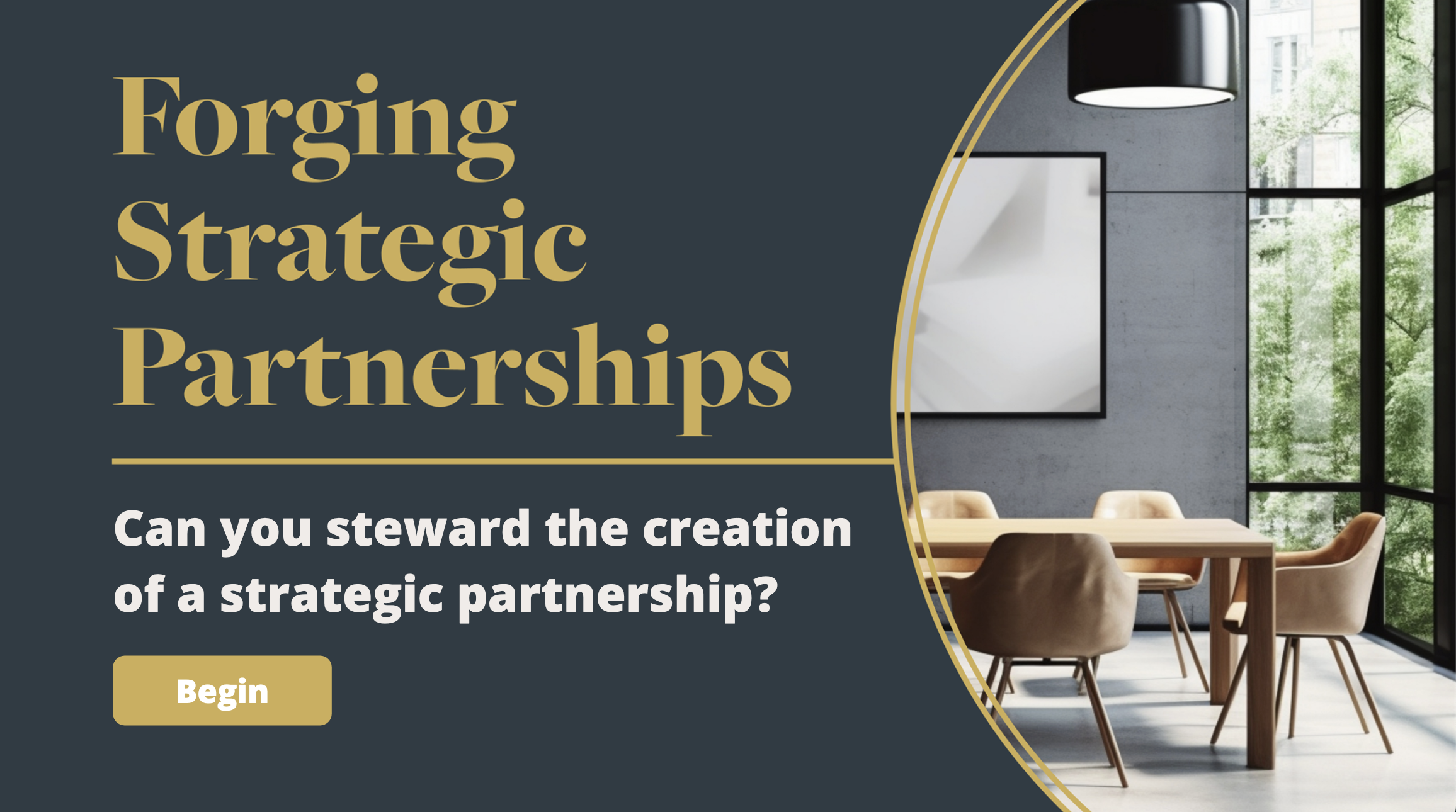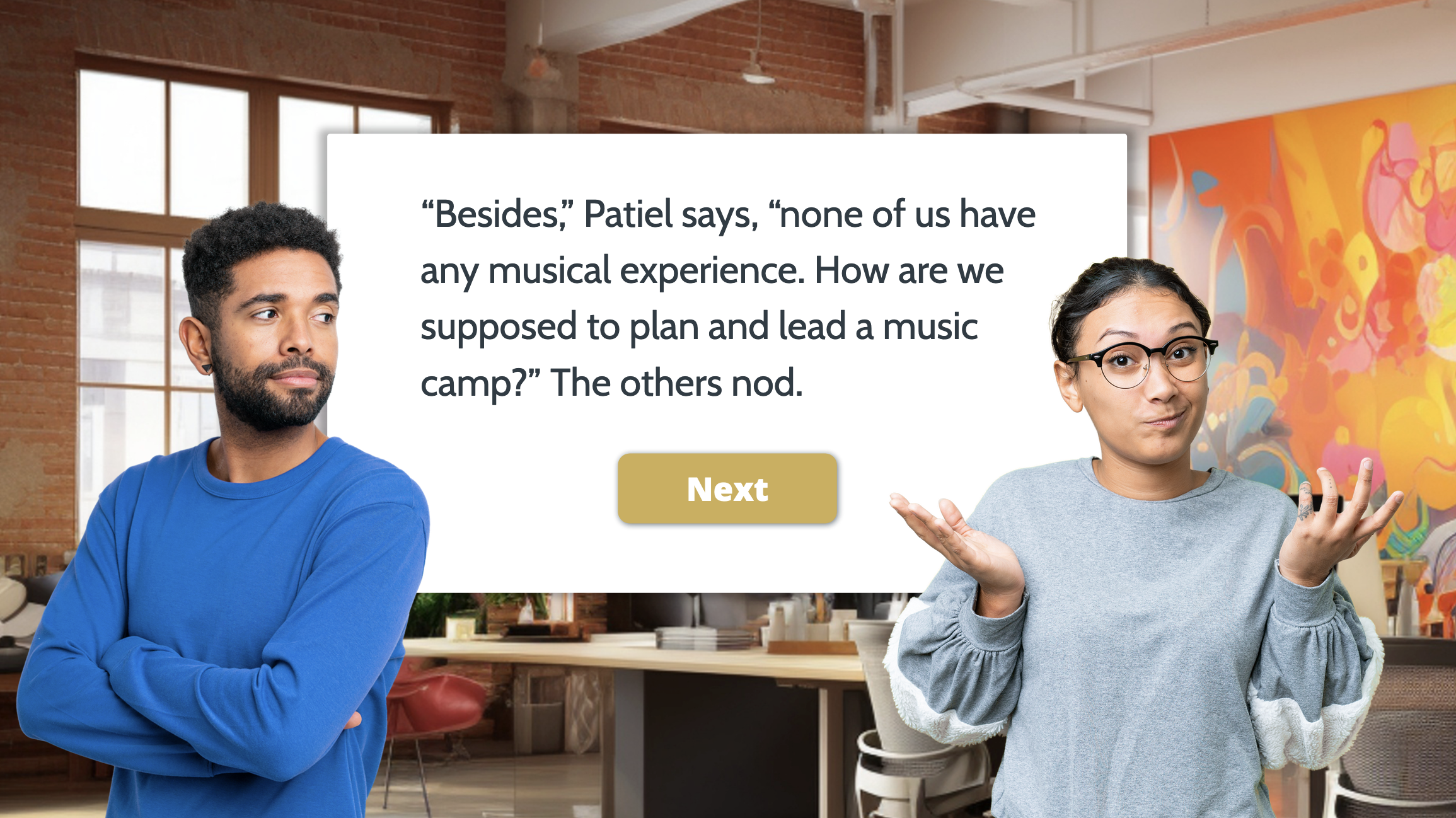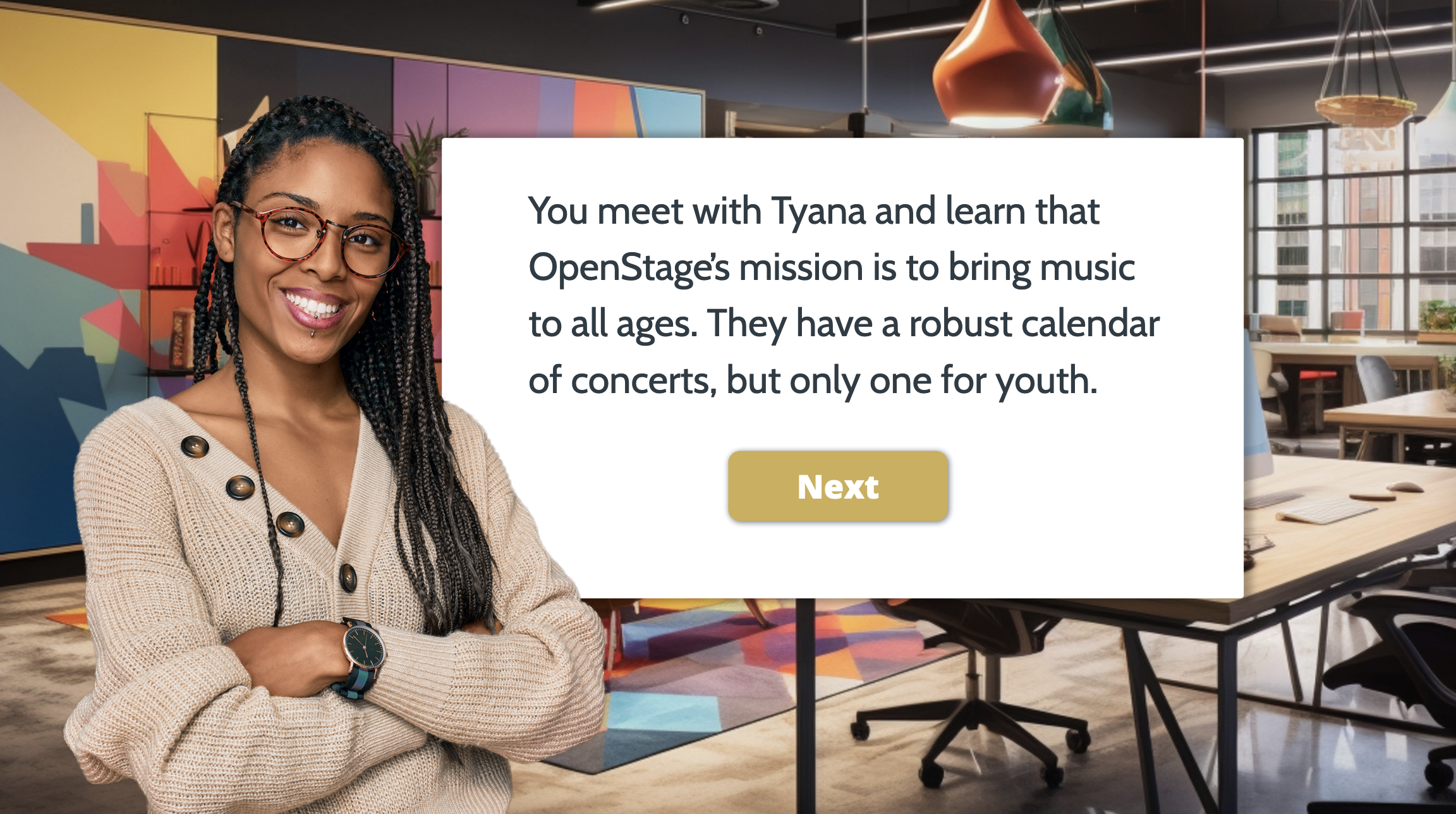
Forging Strategic Partnerships
Forging Partnerships
a branching scenario eLearning simulation for new managers
audience
New or recently promoted managers
tools
Articulate Storyline 360 · Adobe XD · Adobe Photoshop · Adobe Illustrator · Twine · MindMeister · Microsoft Word
responsibilities
I developed every aspect of the project, from ideation through development. Main responsibilities included instructional design, action mapping, content writing, visual and graphic design, and storyboarding the branching scenario.
The Problem
This concept project is for an organization that has experienced significant growth over the last few years. Because the majority of the staff are newer and less experienced, they overcommit the organization’s resources to partnerships that drain staff time and budget, preventing the organization from pursuing higher-impact projects.
The Solution
Because I have extensive experience in project management and forging award-winning partnerships as a startup executive director, I acted as the SME.
I defined the problem and used action mapping to analyze if this was a performance problem that could be solved through training. My solutions included a self-paced, branching scenario eLearning simulation, a job aid for evaluating partnerships, a live practice session, and monthly practice scenarios posted on the staff discussion board.
Given that negotiating partnerships is a complex skill, a branching scenario simulation would let staff practice negotiating and experience long-term consequences when partnerships were not in the organization’s best interest. It would also allow staff to practice recovering when they made mistakes. At the live practice session, staff would apply their learning to existing partnerships using the partnerships job aid in a “partnership audit.”
My Process
I used action mapping to (1) outline the steps to form a strategic partnership, (2) analyze why staff failed to form strategic partnerships using insights from a senior staff member and the executive director, and (3) evaluate if this was a performance problem that could be solved through training. After outlining all solutions, I focused on developing the branching scenario eLearning simulation and the job aid using Meyer’s multimedia principles and Gagne’s nine events to optimize engagement and maximize learning.
For the eLearning simulation, I created a sample scenario that I had other SMEs review and approve before I created the full storyboard content, visual mockups, and a functional prototype using Twine. Each stage was reviewed, refined, and approved before I created the final product in Storyline. Simultaneously, I outlined the job aid content and received approval before graphically designing this tool and integrating it into the eLearning simulation.
Action map
I am a strong believer in action mapping (see Cathy Moore) to ensure solutions actually change behavior and consider both common mistakes and environmental factors that influence behavior. As the SME for this project, I drew from my experience as a startup executive director and my education in organizational leadership. The action map includes steps and details for forming solid partnerships and support a measurable goal of increasing the organization’s overall capacity by 25%. This map ensures the final eLearning simulation will only include relevant and educational activities for the learner.
Text-based functional prototype
Given the complexity of writing a branching scenario with multiple storylines, I used Twine to first map the type of options at each decision point (best choice, mediocre choice, and common mistakes). I then expanded each decision point into a storyline with characters and dialogue. I used my television script-writing experience as well as my work as a creative writer to create realistic, believable scenes that tempt the learner to make common mistakes while offering optional access to advice from a fictional consultant as well as a job aid.
To ensure the prototype worked before full development, the published, functional prototype was shared with another SME: a nonprofit consultant experienced in partnerships. His feedback was very positive and he pinpointed a few instances where a change in dialogue or information would enhance the user experience. I integrated these suggestions into the final prototype.
Job aid development
Because I wanted the learners to be able to access an optional job aid during the live practice session and eLearning simulation, I used the action map to outline and then design two versions of a Strategic Partnerships Job Aid. The first was an 8.5” x 11” printable version (CMYK), and the second was a 16:9 digital version (RGB) for Storyline 360 that left room for navigation and help buttons in the upper right.
8.5” x 11” printable version (CMYK)
Digital 16:9 version for Storyline (RGB)
SME feedback
Since I acted as SME, I wanted to ensure the prototype was effective before full development, so I shared the published, functional prototype with another SME: a nonprofit consultant experienced in partnerships. His feedback was very positive and he pinpointed a few instances where a change in dialogue or information would enhance the user experience. I integrated these suggestions into the final prototype. I also sought SME feedback on the Strategic Partnership Job Aid that would be integrated into the final eLearning. The high contrast and simplicity of the layout were applauded, and I was told the steps and evaluative questions included were comprehensive.
Style guide & visual mockups
I used my decades of experience as a freelance designer to create a modern style guide and mockups for each type of Storyline slide. Given the relational and emotional challenges of stewarding new partnerships, I chose photo-realistic characters and settings to make the decision points feel authentic. To keep the learner’s attention and minimize cognitive load, I broke text into small doses and kept each slide simple, full of contrast, and visually appealing.
Full development
After applying the additional SME feedback, I developed the final product. The programming emphasizes smooth animations to create an immersive, intuitive experience for the user. I used subtle color and graphic changes—such as photo-blur effects and starbursts—to indicate both decision points and if the user’s choices were strategic or not. I also chose characters that incorporated diversity into the eLearning.




The Results
I believe in data-driven results and evaluation at every step of the implementation process. Since this is a conceptual project, I do not have data to provide feedback on whether the staff capacity increased as a result of program managers forming partnerships that netted new resources for the organization, or to survey how staff reacted to both the eLearning and live practice session. That said, those who worked in the nonprofit field and tested the eLearning project reacted very positively and reported learning new aspects of forming strong partnerships. All appreciated the ability to learn from their mistakes and course-correct when they made a decision that was not ideal or in the fictional organization’s best interest.
One tester said, “Even though I knew it was fictional, I felt the stakes were high. I liked that I could see the consequences down the road when I made a poor choice as this accelerated my understanding and allowed me to think strategically when I had a chance to try again. To me, this learning approach was far more effective and engaging than a traditional training.” They also liked the subtle color and graphic changes that indicated one made a wise decision and kept the partnership on track as this provided instant feedback and motivation.
Another said, “You’ve done a masterful job of capturing the tension between the program delivery team and the development department. The correct answers encourage users of the simulation to follow the paths of gathering more information, obtaining team input, pursuing solutions, and keeping the process moving forward toward a win-win resolution.” My choice to design this training as a scenario-based simulation driven by the learner rather than by information proved to be an effective strategy based on this feedback.




